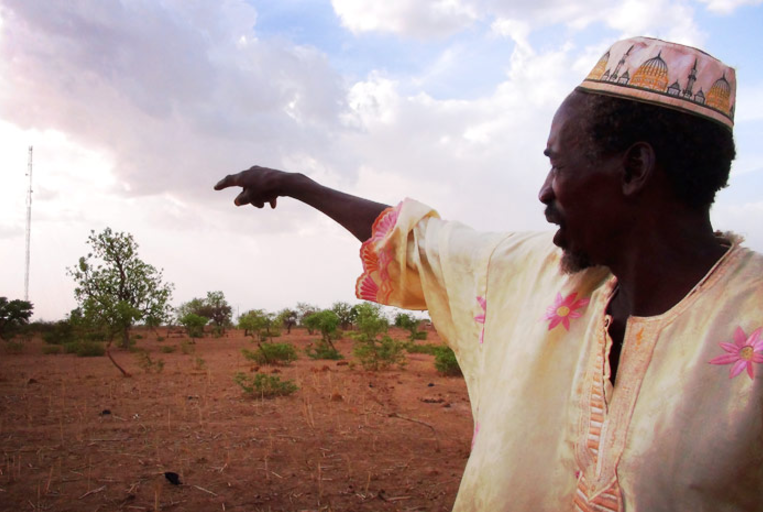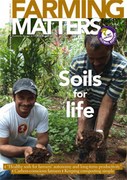In semi-arid cropping regions of West Africa, fallow periods are getting shorter. As land becomes more scarce, farmers are not able to give their soils enough time to rest. This is leading to depletion of soil organic matter, severely threatening soil fertility and damaging soil structure. In the worst cases, crops hardly yield anything anymore. But this is not an option for family farmers. In Burkina Faso, some have found ways to restore their soils that have been dubbed ‘slash and mulch’. The improvement and spread of these techniques also proves the importance of partnerships between farmers and researchers in developing locally suited practices.

Idrissa Ouédraogo lives in Yilou, a village in the Central Plateau of Burkina Faso, with his wife Fatimata Sawadogo, and their children Nafisatou and Felicité. They grow mainly sorghum and cowpea, and also raise chickens, sheep and goats on a plot Idrissa was given some years ago as a gift from an elder. The soil had a hard surface crust and was completely degraded (known locally as zippélé). Nothing would grow on it, not even grasses. But Idrissa had a vision. He knew he had to bring back the native vegetation if he wanted to grow food. And he knew which shrub he needed, baagandé, or camel’s foot (Piliostigma reticulatum).
Idrissa first built stone bunds along contours of his plot to decrease rainwater runoff. This was supported by PATECORE, a development project that financed the installation of soil conservation measures by farmers throughout the region. Then, branches of camel’s foot, including leaves and pods, were cut from the surrounding scrub and added as mulch to thezippélé areas. After a few weeks, he noticed that some of the pods sprouted and camel’s foot was growing on the field. Months later, Idrissa allowed cattle to feed on the plot during the dry season. The animals would consume the fruits of this shrub while leaving precious manure on the field. When the rains started, the seeds, partly digested by the animals, sprouted from the manure on the field, beginning a process of regreening the degraded land. Clever! His job during the first years of this experiment was to observe what would happen and how the land would react.
Idrissa’s use of camel’s foot, one of the most abundant shrubs in the landscape, has added value, indeed. The shrub not only helps restore the soil, but also has many uses, being a valuable multipurpose plant. Bark is used to make ropes, leaves to wrap food, pods are a rich fodder for animals, and branches as fuel wood for cooking. Local farming families know all this, but the additional function of using branches as a mulch to restore degraded lands may encourage farming families to plant more native shrubs on and around their fields
Catching and holding the rain
Food production in Yilou, semi-arid Burkina Faso and in much of dryland Africa, is supported by only three to four months of rainfall each year. The main crops around Yilou are sorghum, cowpea, sesame, okra and other vegetables, hibiscus, and maize around the homesteads. But producing enough food to sustain family nutrition year round is an enormous challenge. Typically, farmers quickly prepare their land at the start of the rains in early June, plant by mid-June, and hope that the rains are abundant and evenly spread throughout the season.
Next to treasured rainfall, soil organic matter is the next most critical ingredient for productive rainfed farming. Basically, rainfall must be able to penetrate the soil and be held there for the crops to use in the weeks after the rain fell. A soil profile that is rich in soil organic matter is better able to perform these two functions.
As rainfall is short and intense, with only an average of 500-600 mm each year, minimising runoff and increasing infiltration are crucial. Also, the more soil is covered, more rain infiltrates and less will evaporate. And reducing runoff with physical barriers such as stone bunds and mulch has the added benefit of reducing soil erosion and sediment loss, an important step in rehabilitating degraded lands.

Agronomists’ offerings complement farmers’ knowledge
Minimum tillage and crop diversification are agronomic techniques, besides stone bunds and mulches, long known and used by West African farmers. NGOs in the region have also promoted Conservation Agriculture, which encourages a third principle: permanent soil cover. Agronomists recommend using crop residues as mulch to cover the soil. However, farmers prefer to use crop residues as animal feed. This limits the quantity of residues available as mulch. What to do when farming families have to choose between feeding their soils and feeding their cows?
This is where farmers’ own expertise comes in, such as in Idrissa’s case. Farming families have come up with their own innovations. Modifications to complement these and make better use of their resources are the result of combining agronomists’ technical knowledge and farmers’ experiential knowledge.
Farmers in Yilou are well aware that they need crop residues for the soil and their livestock, too. They have, however, found a way to get around this tradeoff. Instead of using only crop residues for mulch (in this case sorghum stalks), farmers like Idrissa also cut and add branches of native shrubs such as camel’s foot that grows in the surrounding landscape. And this has proven to be a successful strategy that allows for sufficient soil cover.
The patches of Yilou’s soil that are covered with mulch attract termites. Just a few weeks before the sowing season, the termites consume straw, leaves and branches, burrow them into the soil, and open up underground tunnels. These tunnels channel the rainfall, helping water to infiltrate into the soil rather than running off. The result: crusted soils become useable again, with enough organic matter and storing enough water to grow crops. Farmers in Yilou have observed that crops on such newly restored patches outperform the rest of the field. This new approach, called ‘slash and mulch’, and using only local resources, is kick starting the process of rebuilding soil organic matter.
This is enhanced by farmers’ careful observations. Their soil quality varies, with patches of very good soil intertwined with patches of compacted and crusted soil. So, farmers are precise in their practices and mulch the patches that they see need restoration. They have developed precision agriculture in this semi-arid context. Instead of using global positioning systems, local in-depth knowledge of the soil and the environment is guiding management for this ecological intensification of agriculture.
Ideas worth spreading
Farming families have come up with their own innovations.
‘Slash and mulch’ was developed by elders in Yilou and has been spreading within the region for more than 50 years. To better understand how the system works, participatory action research began in 2013, involving local farmers and agronomists. Experiments on farmers’ fields and research stations are underway to evaluate how different amounts of mulch impact crop yields. Farmer field schools and learning sessions where farmers play with different management scenarios, so called ‘companion modelling platforms’, have also been initiated.
Preliminary results on pilot tests in Yilou have shown that mulching with two tonnes of camel’s foot per hectare doubled sorghum yields. But even the highest crop yields of around one tonne per hectare are still relatively poor in comparison with other regions, and farmers are busy discussing the successes but also the limitations of their innovation. Some of them acknowledge that there used to be much more vegetation in the landscape, and consider that having more trees and shrubs is what they want and need to restore their soil.
A youth came one day to Idrissa’s farm from another village 35 km south of Yilou to harvest camel’s foot bark. He wanted to make rope out of the plant and travelled so far because in his own village, Tem Gorki, there is virtually no camel’s foot left since farmers generally slash and burn them. Idrissa shared his wisdom with the youth: “Instead of harvesting the bark, take some seeds and plant them.” He explained that the technique is simple: “If you don’t have shrubs on your field, just pick some mature fruits and leave the seeds in water for one night, make a little planting hole in your field and place the seeds with a bit of soil; after three weeks you will see them grow.” The young boy followed the advice and came back a year later with a chicken to thank Idrissa.
Learning from experience
The result: crusted soils become useable again, with enough organic matter and storing enough water to grow crops.
Farmers in Yilou know well that crop production is only possible with careful management of soil organic matter, especially where rainfall is limited and increasingly unreliable. Mulching soils with branches from native shrubs, and regenerating native vegetation are two practical ways to rebuild lost soil organic matter and to be able to continue farming.
Of course, camel’s foot has a number of benefits on the field but it cannot occupy the largest share of cropping lands and, its presence should not compete with crops nor interfere with tillage operations. But, when using ‘slash and mulch’, doubling sorghum yields easily compensates for growing camel’s foot on part of the cropping land. One of the next challenges is to find the most suitable density of camel’s foot shrubs to produce the most food with the least work.
Collaboration between farmers and agronomists can lead to practical, innovative and technically sound solutions. Putting into practice the Conservation Agriculture principle of maintaining permanent soil cover and overcoming the trade-off between feeding animals or mulching the soil, is only possible when farmers and researchers share their knowledge and start experimenting together. There are farmer innovators throughout the whole of semi-arid West Africa. Their innovations need to be understood, explored, and extended, to ensure that life is brought back to their degraded lands and they can produce sufficient food to feed themselves.
Georges Félix
Georges Félix is a member of the Latin American Scientific Society for Agroecology (SOCLA). He is from Puerto Rico and a PhD candidate at Farming Systems Ecology, Wageningen University, The Netherlands, working on a programme on woody amendments for Sudano-Sahelian agroecosystems (www.wassa-eu.org).
Email: georges.felix@wur.nl

